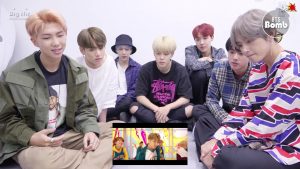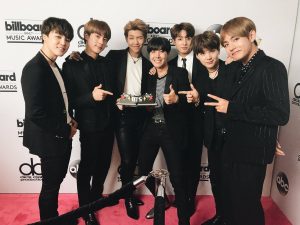 The world – or at least the world as it exists on the internet – was waiting with bated breath for “DNA”, the latest kaleidoscopic MV from BTS. On the day of its release, the video racked up the most YouTube views for any K-pop song in the first 24 hours of its release. Simultaneously the new album Love Yourself: Her climbed to number 7 on the Billboard Hot 200. With both western and eastern media watching for the first time after the group’s win at the 2017 Billboard Music Awards (BBMA), BTS were breaking records, and demonstrating a direct translation of their online power into impressive sales figures. And as fans the world over were replaying the video, BTS responded by flipping the mirror, and uploading their own reaction to the MV; the ultimate way to share the experience and excitement with their fans.
The world – or at least the world as it exists on the internet – was waiting with bated breath for “DNA”, the latest kaleidoscopic MV from BTS. On the day of its release, the video racked up the most YouTube views for any K-pop song in the first 24 hours of its release. Simultaneously the new album Love Yourself: Her climbed to number 7 on the Billboard Hot 200. With both western and eastern media watching for the first time after the group’s win at the 2017 Billboard Music Awards (BBMA), BTS were breaking records, and demonstrating a direct translation of their online power into impressive sales figures. And as fans the world over were replaying the video, BTS responded by flipping the mirror, and uploading their own reaction to the MV; the ultimate way to share the experience and excitement with their fans.
 The rise of the reaction video as a new media form is evidence of our need to share the content we love with other people. But this is a world where we no longer huddle around a single family TV to watch the only program showing, but instead many of us tend to stare at our own solitary screens. The internet gives us the autonomy to curate our own entertainment, and while this has enabled K-pop to build a global fanbase with immense clout on social media, this distance often makes it difficult for fans to find like-minded people. Thus, the reaction video has become a way for K-pop fans to reach out to others across the internet, and even build huge followings by sharing relatable, entertaining responses to the latest MVs. The reaction stars are watching the same groups you love, are equally as hyped, and needed to tell everyone about their feels. YouTube’s bubble of user-generated content has made this possible.
The rise of the reaction video as a new media form is evidence of our need to share the content we love with other people. But this is a world where we no longer huddle around a single family TV to watch the only program showing, but instead many of us tend to stare at our own solitary screens. The internet gives us the autonomy to curate our own entertainment, and while this has enabled K-pop to build a global fanbase with immense clout on social media, this distance often makes it difficult for fans to find like-minded people. Thus, the reaction video has become a way for K-pop fans to reach out to others across the internet, and even build huge followings by sharing relatable, entertaining responses to the latest MVs. The reaction stars are watching the same groups you love, are equally as hyped, and needed to tell everyone about their feels. YouTube’s bubble of user-generated content has made this possible.
But are these YouTubers creating reaction videos simply to engage with other fans or are they riding the hype to further their own fame? Do reaction videos bring fans together or create their own set of divisions? The prevalence of K-pop reaction videos on YouTube can make it seem like everyone is up on the latest releases. How much of this impression is merely a bubble that exists solely online, and does it translate to real-world fan support?

One YouTuber who defines the reaction video in its purest form, and has built a career as a fan creating content to entertain other fans, is JRE of JREKML. The channel has amassed over 1 million subscribers who tune in to watch his timely MV reactions, hilarious skits and concert reviews. And while JRE is that hyped fanboy friend we all wish we had in real life, and is clearly doing it for the love, his status as a popular YouTuber has given him unique opportunities to meet and interview K-pop idols, and attend numerous concerts many fans do not have the means to see.
By sharing his reactions of these encounters via vlogs, JREKML is creating content that encourages fans to not only share in his experiences but live vicariously through his channel. As a famous fanboy, JRE even sells his own merchandise. Is it right for a fan to spend money supporting the adventures of a YouTuber they dream of sharing, instead of putting it towards saving for such concert tickets themselves? Or is wearing a ‘Jreamer’ snapback simply a way of identifying oneself as part of the K-Pop fandom? After all, if you’re stuck in a small town where no K-pop star will ever visit, surely it’s better to have access to JRE’s fancams than not.
Then there are YouTubers who are blatantly using K-pop to further their own gain, and show no shame in doing so. FBE, formerly branded as The Fine Bros, have largely come to define the reaction video form. They churn out multiple videos each week, and have fitted K-pop neatly into their teens, kids and YouTubers react segments. Arguably their purposes are not to share experiences, but create comedy, sometimes to the detriment of the content they exploit. The reactions of those unfamiliar with K-pop to MVs by some its most popular and acclaimed stars has drawn much ire from fans. It’s waving a red rag at a bull to have some guy mocking SNSD for all looking the same, or a woman criticise Shinee for wearing too much make-up.
 In doing so, FBE brings out the darker side of the internet; the squabbles in the comments section, the casual ignorance, the racist slurs. These are reaction videos that do not bring people together, but divide them, and arguably work to raise the cultural and racial barriers that have kept K-pop from breaking the American mainstream. After all, FBE seems to ask, who would seriously want to watch this?
In doing so, FBE brings out the darker side of the internet; the squabbles in the comments section, the casual ignorance, the racist slurs. These are reaction videos that do not bring people together, but divide them, and arguably work to raise the cultural and racial barriers that have kept K-pop from breaking the American mainstream. After all, FBE seems to ask, who would seriously want to watch this?
Nonetheless, subsequent FBE ‘react to K-pop’ videos have become less about highlighting the otherness of K-pop with each release, and their Q&A segments after each clip are an effective crash course in K-pop for any newbie, giving accurate, interesting information about the Korean music industry. Several YouTubers featured in FBE’s videos have become fans via this introduction, and gone on to produce their own reaction videos, such as Superwoman. In this way FBE’s videos enable K-pop to break out of its own YouTube bubble and interact with established Western YouTubers, furthering its international renown.
YouTube is a platform where creators share content for entertainment, and viewers openly engage with, making it the ideal space for international K-pop fans to connect with one another and their favourite groups online. It’s also the perfect place for creators and fandoms to merge, with sometimes unexpected and brilliant results. When Ryan Higa partnered with Wong Fu Productions , singer David Choi, violinist Ahn Jun-sung, and actor Justin Chon to create the first Asian-American K-pop band, Boys Generally Asian (BgA), the virtual worlds of YouTube and K-pop combined and collectively imploded part of the internet. K-pop media outlets responded to BgA as if it was an official debut and fans reacted not only with numerous reaction videos but digital sales. The response was such that it prompted the YouTubers to follow up the video with a BgA comeback in 2017 with “Who’s It Gonna Be” that topped the US iTunes K-pop chart.
 JREKML reacted. So did K-pop stars Topp Dogg. And so a skit and song originally intended as a parody to entertain K-pop fans was widely acknowledged as part of the K-pop canon.
JREKML reacted. So did K-pop stars Topp Dogg. And so a skit and song originally intended as a parody to entertain K-pop fans was widely acknowledged as part of the K-pop canon.
BgA briefly topping the charts demonstrates not only the power of K-pop fans to band together and achieve real-world results, but also the culture of user-interaction that makes YouTube content unique. It was not the complex promotional strategies of traditional record labels that enabled BgA to release a hit. It was the response of the fans, and the domino effect of the MV and reaction videos to it being shared around the internet that spread awareness of the song and created its success.
The parodic form of the BgA skit itself can also be seen as a reaction to K-pop – but unlike FBE content, this is not comedy created purely for its own sake, but to relate to its viewers. The K-pop fan response was so great not only because they connected to the clip, but because Ryan Higa and other American YouTubers were creating K-pop themed content catered to K-pop fans, and acknowledging the presence of the online K-pop community.
Ultimately, the interaction surrounding reaction videos exists solely on YouTube. However popular K-pop may seem to be within this bubble, it is yet to be accepted by the Western mainstream. Nonetheless, it is interesting that media outlets such as the BBC, The Fader, and Fuse are now interviewing BTS to promote their recently released album after the BBMA’s Top Social Artist award proved their online power in May. In this way their niche success is translating to mainstream attention, as conventional taste-makers recognise the power of fans to reap commercial results.
K-pop has yet to become an accepted mainstream source of entertainment in the US and Europe as it has done in other Asian countries such as Singapore and Japan. But perhaps it doesn’t need to. The fan from a small Scottish village can still watch KCON Mexico, and the ARMY in Taiwan can attend The Wings Tour and compare it to JREKML’s experience of the show in NYC. Technology has shifted previous constraints and music from different countries is becoming increasingly accessible and accepted. With young people’s growing preference for user-generated content over traditional media sources, K-pop has already transcended established borders to become globally popular, shared by fans around the world.
(Billboard [1][2][3], YouTube [1][2][3][4][5], Instagram, Images via Big Hit Entertainment, JREKML, FBE, Ryan Higa)


